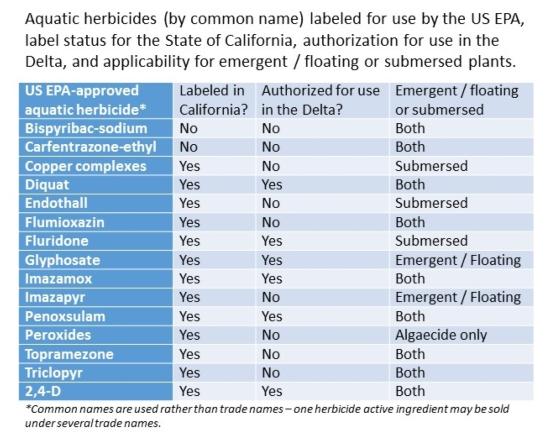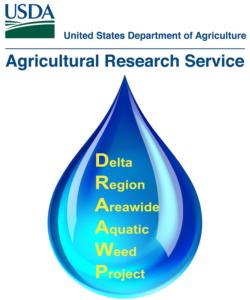Chemical control
Herbicides labeled for aquatic use can be classified as either contact or systemic (see table). Contact herbicides act rapidly on the tissues contacted, typically causing extensive cellular damage and membrane leakage. These compounds do not translocated to the below sediment vegetative reproductive structures such as root crowns, roots, or rhizomes of perennial plants. As such, they are considered more effective on annual weeds. Systemic herbicides are translocated throughout the above and below sediment portions of the plant. They require a longer time to exert their effect but are much more effective on perennial plants compared to contact herbicides.

Complexed copper compounds include a variety of chelated formulations of copper that keep the active ingredient in solution much longer than unchelated copper sulfate. Because copper rapidly precipitates, especially in harder water, it is not as effective for control of algae and some macrophytes (particularly hydrilla) as the chelated formulations. Some formulations of copper are also effective for controlling some submersed aquatic plants, like hydrilla and Brazilian egeria.

For control of submerged aquatic species, applications of herbicides are made directly to the water column. This can be surface or subsurface applications as a solution, crystal, or granule formulation. The herbicide is rapidly and directly taken up by the plant tissues within the water column, as these plants do not contain a waxy cuticle barrier on their epidermis. To be efficient, applicators must have a thorough knowledge of the exchange rate of the water, as well as the herbicide concentration and proper exposure time required to obtain effective control of the target species. The response of different plant species to different herbicides becomes a function of these factors. With this knowledge, an effective herbicide concentration can be used that will also minimize potential environmental problems and reduce costs.

While most aquatic herbicides have use patterns for both submersed and emergent plants, a few are only appropriate for one or the other. Imazapyr and glyphosate, for instance, are inactivated once they are in the water, and so are used only as a foliar spray on emergent and floating plants. Other aquatic herbicides, specifically copper complexes, endothall, and fluridone, only have applications for submersed species.




